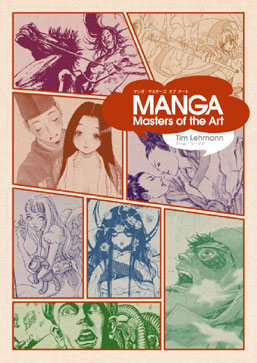A Glimpse into the Creative Spaces of Manga

It is immediately clear that the book is intended as a reference text. Lehman begins with a series of story genre charts featuring each artist and the genres their work fits into: surrealism, realism, SF/fantasy, horror, and so on. This is followed by an art style chart, built on Scott McCloud’s Understanding Comics: The Invisible Art, that places the Japanese manga artists on a chart with western comic artists and animators to illustrate the similarities and differences between them. Having Japanese manga artists’ styles charted with western artists shows how visual art cultures spread and overlap. Since many of the featured Japanese artists cite French and American comic artists as influences we can see a flow of ideas-from West to East and back. A historical timeline of Japanese manga is also included.
Brief introductions to each artist are followed by interviews discussing their creative process — how they get ideas, how they got started in the profession, and what themes drive their work. This being an art book for artists, Lehman also spends considerable interview time on questions about work schedules and preferred art supplies; including the ongoing debate around use of computers in creating manga. Each interview, about five to six pages long, is interspersed with example panels from each of the artists’ most well-known manga. Detailed lists of works, both those produced in Japanese and those translated into English, are also provided; while translations into others languages are not always included, they are cited amply in the interview text and bibliography. Lehman also treats us to a full color section, in which each artist has a few pages of color illustrations. Most manga is in black and white, but seeing many of the creations in color offers the reader a chance to view favored manga styles in a new way.
The real treat of Lehman’s work is the wonderful page layout of the artists’ studio following each interview. Pictures of work desks, favored art supplies, books, knick-knacks gives the reader insight into the artists’s workspaces — these photos add a real sense of richness to the interviews. We can see Tatsuya Egawa’s notebooks and assorted doodles, as well as Takehiko Inoue’s cluttered workspace of old magazines and athletic shoes recalling the Slam Dunk! manga for which he is famous. Meanwhie, Erica Sakurazawa’s well organized workspace has the same stylishness and clean lines as her manga, whereas Miou Takaya’s workspace show the Victorian/mythological themed knickknacks and influences that directly impact her works. Other artists featured are Asamiya Kia, CLAMP, Furuya Usamaru, Maruo Suehiro, Okano Reiko, Taniguchi Jiro, Tsuno Yuko, and Hiroki Mafuyu. Lehman is revealing the connections of personal style that flows through all of these artists’ work, and likely contribute directly to the success of their manga. Any creative endeavor is appreciated most when it is real and honest…and Lehman’s book demonstrates the process of that honesty. This book is a welcome addition to a collection of works that cover manga and for general comics, manga, and animation enthusiasts.
Lastly, one note of caution: The interviews and illustrations include manga that feature a variety of adult themes, and; not just ‘children’s’ manga. Discretion is advised if considering this book as a gift for young children.
Winnie Shiraishi
Winnie Shiraishi



